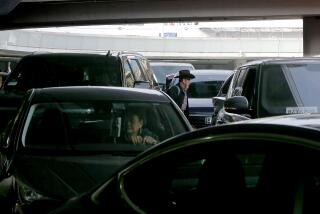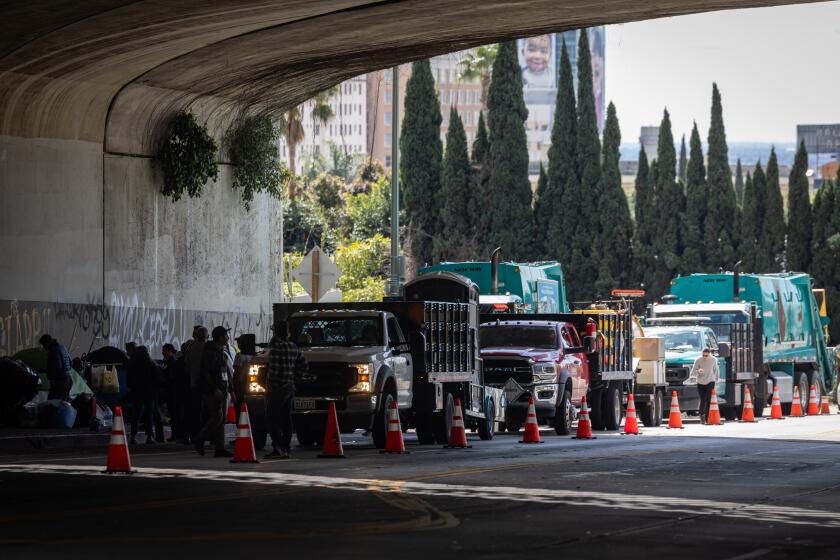Gina Marie Lindsey: She’s piloting LAX into the 21st century
Don’t think that Gina Marie Lindsey is up in an ivory control tower. This week, the executive director of Los Angeles World Airports will be joining an estimated 2.6 million passengers in the Christmas/New Year’s scrum at LAX, on her own holiday travels. In 2007, the woman who once ran Seattle’s airport was appointed to run L.A.’s by Mayor Antonio Villaraigosa. In October, Mayor Eric Garcetti decided to keep Lindsey on to, in her words, “continue to push this” — Los Angeles International Airport — forward.”
Is Christmas LAX’s busiest time?
From a traveler’s standpoint it is; I don’t know whether we can tell the difference anymore. Thanksgiving is more concentrated; Christmas is stretched out. A study of the top 20 airports across the nation [was] projecting how many days like the Wednesday before Thanksgiving those airports were going to have in five or 10 years. LAX and several others were going to have several days a week like the Wednesday before Thanksgiving.
2013 ENDINGS: Columnist Patt Morrison on what she won’t miss
The tricky thing at LAX is that we’re so far behind the 8-ball, we’ve got to cover the distance between where we are today and current expectations, but we have to also plan for the capacity we know is going to be demanded in the future.
What capacity was the airport built for, and where is it now?
It’s complicated. There are three [potential problem] sectors: a bottleneck on the airfield, a bottleneck in the terminals or a bottleneck in the [airport] road system. They don’t match. The trick to good airport planning and development is to make them all have equal capacity.
What’s been the impact of the Nov. 1 shooting of the TSA agent?
A huge effect on the staff because we’re doing a very, very thorough after-action report. We’re already putting together an airport response team if we have multiple hours of an airport closure. You don’t know exactly when you can open again. We need to send staff to wherever people are waiting — on Nov. 1, we had people out close to Century Boulevard. We need to hand out water, give them whatever information we have, just do a little person-to-person care. We were doing some of that but not as much as the duration of the event demanded.
YEAR IN REVIEW: 6 developments that changed Latin America in 2013
We have about 1,700 operations a day coming in and out. On that day, we still had 1,370 flights operate. The airport did a pretty remarkable job to get back and operational.
What kind of emergency system is in place?
A couple of years ago we activated the airport response coordination center. Up to that point there had never been an operations center for LAX, which was surprising to me. It’s got good IT and camera availabilities, and emergency notification capabilities to all the airlines and service providers.
The new Tom Bradley International Terminal is very nice, but LAX’s reputation is still grim compared to other airports. How much of it is deserved?
You look worldwide and airports are becoming incredibly wonderful public spaces. LAX didn’t keep pace with that. It didn’t even keep pace with what was happening in the United States.
YEAR IN REVIEW: Kindness in the world of politics? 7 uplifting examples from 2013
Over time, when you have dogeared facilities, a lot of the employee base tend to reduce their expectations of what the experience should be. That’s my best guess as to how we slid in our service level.
We’re trying to demonstrate that we can do world-class things; the new Bradley west terminal demonstrates that. I’ve seen an incredible change in the employees [there]. You tend to subliminally expect yourself to deliver something commensurate with the surroundings.
It is going to happen incrementally; you can’t reconstruct the whole airport at the same time. You may remember the vale of tears about three years ago, the first time in about 20 years there had been significant procurement for new concessionaires at LAX. We went out for direct leasing opportunities and we got our clocks cleaned by the political process after the selections, because whoever didn’t win seemed automatically to be a victim. That was a really painful process.
However, we got through it and you will find new concessions in every terminal. I ate at Campanile in Terminal 4 [recently] and it was fabulous. The concessions are not improved in Terminals 1, 2, 3 and 6, but they’ll get there.
Is LAX’s relationship with concessions so different from other airports?
No, it’s not. The difference is other airports have a more streamlined procurement process than we do. The world is increasingly competitive; if we’re going to make the most of our assets, we need to be able to be entrepreneurial.
How much of that lag is a function of the relationship between the airlines and the airport?
The relationship between the airport and the airlines was very rocky because the airport was pursuing a rates and charges policy that was not industry standard. We have changed that.
We have an extremely good relationship with the airlines now; they’re leaning forward to help us get as much done as we can. They’re even taking on improvements in their own terminals. Delta, $250 million in Terminal 5; Southwest, $400 million in Terminal 1; United is about $400 million for Terminals 7 and 8. We buy back some of the resulting public space improvements. That would never have happened 10 years ago.
You must hate reading critical surveys and bad rankings.
I want to say, just give us time! And we really don’t have all that much time.
How do you avoid those “I hate LAX” diatribes at parties?
I usually say I drive a bread truck!
What about getting into the airport? What about a people-mover system and a transit hub off-site?
[I’m hoping for] a intermodal transportation facility and an automated people-mover system to come into the central terminal.
From my standpoint, Transportation Planning 101 would say locate as many modes as you can on one footprint: You get on the people mover, you go to the intermodal transportation facility, you have a Culver City bus, a Santa Monica bus, a Metro bus, a light rail, a shared-ride van, a flyaway bus — all in that little footprint.
That makes sense to us, but we don’t have all the challenges that MTA has. MTA has to decide where the airport connection will be. They’re studying alternatives. They’re building the Crenshaw station at Aviation and Century; that’s a long way away [from LAX]. We suggested it might make sense for them to bend the [Crenshaw] line, but there are a lot of considerations. The reason this place is so fascinating is the planning conundrums.
Will people be barred from driving into the airport at some point?
I don’t see that today. We’re suggesting the commercial vehicles — the flyaway buses, the [city] buses, shared-ride vans — all eventually come to an intermodal transportation facility, which frees up roadways here for private vehicles.
People often forget Los Angeles World Airports includes the Ontario and Palmdale airports. Ontario in particular has had problems attracting air traffic.
Largely the reason it is struggling is because airlines have changed their business model and are concentrating on major hubs. Long term, Ontario is going to be fine, but it’s going to be awhile.
Are you concerned that some airlines might decide to skip LAX altogether?
Based on what I see, there’s no reason to be concerned about that, although if we do not continue modernizing, if we don’t meet customer service demands, then I think we should worry about whether we’re going to have the economic engine we currently have.
If you could reverse-engineer LAX, how different would it look?
Very! I’d probably have three major terminals with several concourses each. That would resolve the interconnectivity problem. And I’d have more roadway frontage.
We were just listed by USA Today as being the most difficult airport from an air-traffic control standpoint because of the challenges with the big aircraft.
What’s going on with the nifty Theme building?
The current [restaurant] operator wants to be out by the end of the year. We’ve reached out to other concessionaires, and I think one or two are interested. The problem is, it was built when bringing your family out to have dinner and watch the airplanes was a cool thing to do. Passengers [now] won’t leave the terminals to have dinner there because it’s unpredictable how long it’ll take them to get through security again.
And it’s so difficult for people to just come here to meet passengers during long layovers.
Pre-9/11 you could do that because the screening process was less rigorous and less time-consuming. The [TSA] said no, we’re only going to screen people who have to be screened, the passengers.
The actress Angie Dickinson has been advocating numbering the Bradley terminal; she says everyone can recognize numbers, even if they can’t read the name “Tom Bradley.”
She must be talking to the station manager for Air France, who wants that too! It would mean all the other [terminals] on the south get renumbered.
Are you looking forward to the day we can all just teleport ourselves, like characters on “Star Trek”?
Not until we’ve amortized all the investments at LAX!
This interview has been edited and excerpted from a transcript. patt.morrison@latimes.com.
Twitter: @pattmlatimes
More to Read
A cure for the common opinion
Get thought-provoking perspectives with our weekly newsletter.
You may occasionally receive promotional content from the Los Angeles Times.







